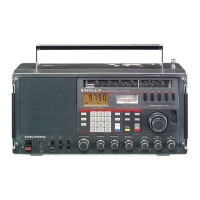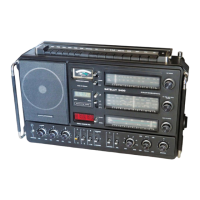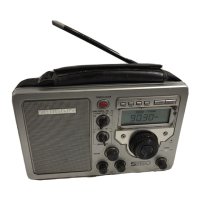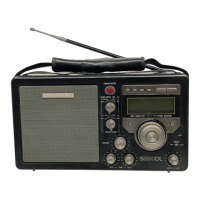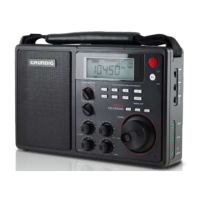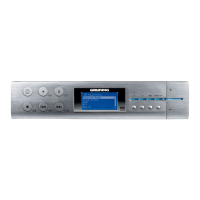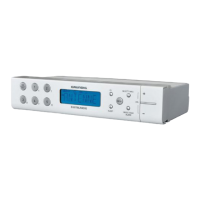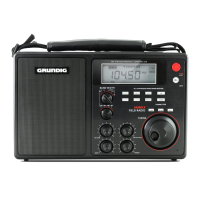Do you have a question about the Grundig SATELLIT 600 PROFESSIONAL and is the answer not in the manual?
Controls automatic vs manual radio on/off operation based on programming.
Connection for external headphones (6.3 mm jack plug, approx. 100 ohm).
Selects built-in broadband speaker, tweeter only, or external speaker.
Checks battery status or illuminates scale, display, and meter.
Activates Automatic Noise Limiter for reducing static and clicks in AM reception.
Adjusts the audio output volume (LAUTST./VOLUME).
Adjusts the low-frequency audio response (BÄSSE/BASS).
Adjusts the high-frequency audio response (HÖHEN/TREBLE).
Selects narrow to wide bandwidth for optimal AM reception quality.
Selects Automatic Gain Control (AGC) or Manual Gain Control (MGC) for AM.
Selects reception modes: LSB, AM, or USB for AM wavebands.
Fine-tunes SSB signals using the BFO or CLARIFY control.
Adjusts external aerial signal level for SW reception.
Scans frequency bands manually using a magnetically notched rotary control.
Controls the preselector and provides approximate frequency indication.
Shows time, date, frequency, waveband, and operational status information.
Press to display the current date.
Press to display the current time of day.
Press to display the currently tuned frequency.
Used for entering time, date, switching times, and frequencies.
Recalls stored ON-TIME, OFF-TIME, or preset stations.
Stores entered figures (time, date, station) into memory.
Extendable and tiltable aerial for optimum FM and SW reception.
Selects between the telescopic aerial and an external aerial.
75 ohm socket for connecting an external aerial.
Terminals for connecting external aerial and earth for all wavebands.
Input for tape recorders/record decks, output for amplifiers.
Input for record decks and tape/cassette recorders.
Details on using six HP 2 batteries for radio and two HP 7 for clock/memory.
Information on using a rechargeable Dryfit battery and its charging.
Meter and display indicators for checking battery voltage or charge status.
Operation using the built-in power supply unit from mains voltage.
Specific recommendations for UK users regarding mains plug and fuse.
Instructions on how to safely replace the unit's fuses.
Caution against making improvised repairs to defective fuses to prevent damage.
Using an external 10-16 V DC source, such as in vehicles.
Guidance on extending, swivelling, and rotating for FM and SW reception.
Connecting external aerials to the unit for improved reception.
For receiving mediumwave and longwave broadcasts.
How to switch the radio on and off using the power switch.
How to select audio input sources (AUX) or wavebands (LW, MW, SW, FM).
Adjusting sound quality using volume, bass, and treble controls.
Connection for headphones, which mutes the internal loudspeaker.
Input for amplifying sound from tape recorders or record decks.
Selects built-in speaker operation or external connection.
Adjusts bandwidth for better station separation or sound quality on AM.
Automatic Noise Limiter for reducing interference noise peaks.
Fine-tunes SW reception with external aerial by adjusting signal level.
Guide to using numeric keys for direct frequency input and settings.
How to choose between LW, MW, SW, and FM wavebands.
Controls for switching the automatic preselector and auxiliary tuning scale.
Step-by-step tuning to stations using the rotary tuning control.
Entering frequencies directly via the numerical keyboard.
Procedures for tuning AM stations by entering their frequencies.
Procedures for tuning FM stations by entering their frequencies.
How to store and retrieve up to 60 preset stations across different bands.
General notes on clock and data entry timing intervals.
How to set the current time using the numerical keyboard and SET button.
How to set the current date using the numerical keyboard and DATE button.
Setting automatic on/off times for the radio up to three times a day.
Details on SSB controls: AGC/MGC, MODE (LSB/AM/USB), BFO/CLARIFY.
Recommendations for optimal SSB unit usage and avoiding distortion.
Detailed guide on tuning and receiving SSB broadcasts from radio amateurs.
Details on battery types (HP 2, HP 7) and external DC/mains power inputs.
Specifications for fuses used in the unit (e.g., 315 mA time-lag).
Electrical output power ratings for battery and mains operation.
Estimated battery duration for different Varta battery types on AM/FM.
Description of separate bass and treble controls, continuously variable.
Details on the permanent-magnet dynamic Superphon loudspeaker and tweeter.
List of supported frequency bands (FM, LW, MW, SW) and their ranges.
Specific shortwave bands with frequency ranges and center frequencies.
Description of integrated aerial types: telescopic and ferrite rod.
List and description of available input/output sockets (e.g., headphone, LINE, PU/TR).
The physical weight of the radio unit without batteries.
Physical size of the radio unit (WxHxD) including handles.
Guidance on cleaning the unit with a soft, anti-static cloth.
Caution regarding exposure to temperatures above 60° C, e.g., in cars.
Guidance for mobile use, including securing the Satellit and screw specifications.
Controls automatic vs manual radio on/off operation based on programming.
Connection for external headphones (6.3 mm jack plug, approx. 100 ohm).
Selects built-in broadband speaker, tweeter only, or external speaker.
Checks battery status or illuminates scale, display, and meter.
Activates Automatic Noise Limiter for reducing static and clicks in AM reception.
Adjusts the audio output volume (LAUTST./VOLUME).
Adjusts the low-frequency audio response (BÄSSE/BASS).
Adjusts the high-frequency audio response (HÖHEN/TREBLE).
Selects narrow to wide bandwidth for optimal AM reception quality.
Selects Automatic Gain Control (AGC) or Manual Gain Control (MGC) for AM.
Selects reception modes: LSB, AM, or USB for AM wavebands.
Fine-tunes SSB signals using the BFO or CLARIFY control.
Adjusts external aerial signal level for SW reception.
Scans frequency bands manually using a magnetically notched rotary control.
Controls the preselector and provides approximate frequency indication.
Shows time, date, frequency, waveband, and operational status information.
Press to display the current date.
Press to display the current time of day.
Press to display the currently tuned frequency.
Used for entering time, date, switching times, and frequencies.
Recalls stored ON-TIME, OFF-TIME, or preset stations.
Stores entered figures (time, date, station) into memory.
Extendable and tiltable aerial for optimum FM and SW reception.
Selects between the telescopic aerial and an external aerial.
75 ohm socket for connecting an external aerial.
Terminals for connecting external aerial and earth for all wavebands.
Input for tape recorders/record decks, output for amplifiers.
Input for record decks and tape/cassette recorders.
Details on using six HP 2 batteries for radio and two HP 7 for clock/memory.
Information on using a rechargeable Dryfit battery and its charging.
Meter and display indicators for checking battery voltage or charge status.
Operation using the built-in power supply unit from mains voltage.
Specific recommendations for UK users regarding mains plug and fuse.
Instructions on how to safely replace the unit's fuses.
Caution against making improvised repairs to defective fuses to prevent damage.
Using an external 10-16 V DC source, such as in vehicles.
Guidance on extending, swivelling, and rotating for FM and SW reception.
Connecting external aerials to the unit for improved reception.
For receiving mediumwave and longwave broadcasts.
How to switch the radio on and off using the power switch.
How to select audio input sources (AUX) or wavebands (LW, MW, SW, FM).
Adjusting sound quality using volume, bass, and treble controls.
Connection for headphones, which mutes the internal loudspeaker.
Input for amplifying sound from tape recorders or record decks.
Selects built-in speaker operation or external connection.
Adjusts bandwidth for better station separation or sound quality on AM.
Automatic Noise Limiter for reducing interference noise peaks.
Fine-tunes SW reception with external aerial by adjusting signal level.
Guide to using numeric keys for direct frequency input and settings.
How to choose between LW, MW, SW, and FM wavebands.
Controls for switching the automatic preselector and auxiliary tuning scale.
Step-by-step tuning to stations using the rotary tuning control.
Entering frequencies directly via the numerical keyboard.
Procedures for tuning AM stations by entering their frequencies.
Procedures for tuning FM stations by entering their frequencies.
How to store and retrieve up to 60 preset stations across different bands.
General notes on clock and data entry timing intervals.
How to set the current time using the numerical keyboard and SET button.
How to set the current date using the numerical keyboard and DATE button.
Setting automatic on/off times for the radio up to three times a day.
Details on SSB controls: AGC/MGC, MODE (LSB/AM/USB), BFO/CLARIFY.
Recommendations for optimal SSB unit usage and avoiding distortion.
Detailed guide on tuning and receiving SSB broadcasts from radio amateurs.
Details on battery types (HP 2, HP 7) and external DC/mains power inputs.
Specifications for fuses used in the unit (e.g., 315 mA time-lag).
Electrical output power ratings for battery and mains operation.
Estimated battery duration for different Varta battery types on AM/FM.
Description of separate bass and treble controls, continuously variable.
Details on the permanent-magnet dynamic Superphon loudspeaker and tweeter.
List of supported frequency bands (FM, LW, MW, SW) and their ranges.
Specific shortwave bands with frequency ranges and center frequencies.
Description of integrated aerial types: telescopic and ferrite rod.
List and description of available input/output sockets (e.g., headphone, LINE, PU/TR).
The physical weight of the radio unit without batteries.
Physical size of the radio unit (WxHxD) including handles.
Guidance on cleaning the unit with a soft, anti-static cloth.
Caution regarding exposure to temperatures above 60° C, e.g., in cars.
Guidance for mobile use, including securing the Satellit and screw specifications.
| battery voltage | 9 V DC |
|---|---|
| external DC supply voltage | 10-16 V DC |
| mains voltage | 220-240 V or 110-127 V |
| battery type | six HP 2 (IEC R 20) batteries |
|---|---|
| clock and memory battery type | Two HP 7 (IEC R 6) batteries |
| battery life with AM | 80 hours |
| output power battery operation | 2.5 W sine |
|---|---|
| output power mains operation | 10 W sine |
| music power | 15 W music power |
| weight | 8.5 kg |
|---|---|
| dimensions | 504x242x202 mm |
